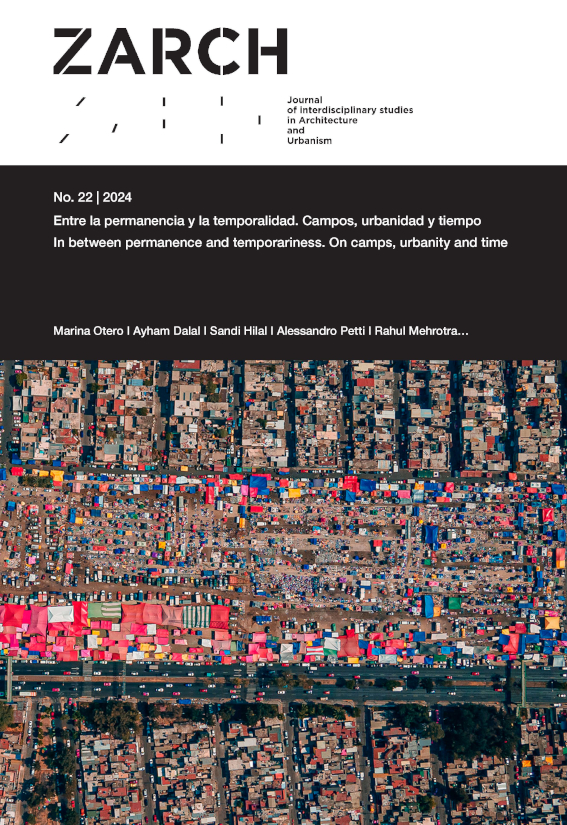From shelters to communities: Frederick Cuny's approach to disaster relief
DOI:
https://doi.org/10.26754/ojs_zarch/zarch.2024229788Keywords:
Frederick Cuny, John F.C. Turner, refugees, camp planning, disaster relief, community participation, sustainable developmentAbstract
This article examines the enduring influence of Frederick Cuny, a pioneering humanitarian whose work revolutionized disaster relief and refugee camp design. It explores Cuny's legacy in reshaping notions of permanence and temporality in camps, blurring the lines between these spaces and conventional cities. Cuny's approach challenged traditional rigid grid layouts, emphasizing community-based, decentralized designs that prioritized open spaces. His principles of community participation, development over aid, and the shift from shelter products to sheltering processes - ideas that the article links to the work of John F.C. Turner - continue to shape contemporary disaster management strategies. By examining two important case studies in which Cuny was involved, Camp Choloma and Program Kuchuba’l, the article also underscores the vital link between the spatial organization of camps and their social dynamics, emphasizing how camps evolve into permanent communities. Cuny's groundbreaking work remains highly pertinent in addressing modern challenges, including natural disasters, ongoing refugee crises, and substandard housing.
Downloads
References
Architecture for Humanity. 2006. Design Like You Give a Damn. London: Thames & Hudson.
Cohen, Michael. "John F.C. Turner and Housing as a Verb", Built Environment (1978-) 41, no. 3 (2015): 412-418. https://www.jstor.org/stable/44131925.
Cuny, Frederick C. A Report on the Coyotepe Refugee Camp in Masaya, Nicaragua. Dallas: INTERTECT, 1973.
Cuny, Frederick C. A Report on the Refugee Camp and Housing Programs in Choloma, Honduras, For the Refugees of Hurricane Fifi: December 1974. Dallas: INTERTECT, 1974.
Cuny, Frederick C. "Refugee Camps and Camp Planning: The State of the Art", Disasters 1, no. 2 (1977): 125-143. https://doi.org/10.1111/j.1467-7717.1977.tb00020.x
Cuny, Frederick C. Strategies and Approaches which can be used by Voluntary Agencies to Provide Post Disaster Shelter and Housing. Dallas: INTERTECT, 1977.
Cuny, Frederick C. "The UNHCR and Relief Operations: A Changing Role", The International Migration Review 15 (1981): 16-19. https://doi.org/10.2307/2545319.
Cuny, Frederick C. Refugee Participation in Emergency Relief Operations. Dallas: INTERTECT, 1987.
Cuny, Frederick C. 1994. Disasters and Development. Dallas: INTERTECT Press.
Cuny, Frederick C. Refugee Camps and Camp Planning. Report I: Camp Planning. Dallas: INTERTECT.
Cuny, Frederick C. Project Manual for an Emergency Shelter-to-Housing Program. Dallas: INTERTECT.
Cutini, Valerio and Buonocore, Michael. "We were building a camp, they were building a city: Refugee camps as a spatial laboratory for spatial inclusion" In Proc., 11th Space Syntax Symp. Lisbon, Portugal: University of Lisbon (2017).
Dalal, Ayham. 2022. From Shelters to Dwellings: The Zaatari Refugee Camp. Berlin: Transcript Verlag.
Dalal, Ayham. "The Refugee as Urban Housing", Housing Studies 37, no. 2 (2022): 189-211. https://doi.org/10.1080/02673037.2020.1782850.
Dantas, Abdon and Amado, Miguel, "Refugee Camp: A Literature Review", Journal of Urban Planning and Development, vol. 149, no. 4 (2023), https://doi.org/10.1061/JUPDDM.UPENG-4311.
Davis, Jan and Lambert, Robert. 2002. Engineering in Emergencies: A Practical Guide for Relief Workers, 2nd ed. London: ITDG.
Global Shelter Cluster. The State of Humanitarian Shelter and Settlements 2018. Geneva: International Federation of Red Cross and Red Crescent Societies, 2018.
Golda-Pongratz, Kathrin. "John FC Turner (1927-)", The Architectural Review, January 11, 2021, https://www.architectural-review.com/essays/reputations/john-fc-turner-1927.
IFRC. Community Engagement and Accountability (CEA) Strategy 2023-2025. Geneva: International Federation of Red Cross and Red Crescent Societies, 2023.
IFRC. Global Plan 2024. Geneva: International Federation of Red Cross and Red Crescent Societies, 2023.
IFRC. Preparedness for Effective Response Leaflet and Case Studies. Geneva: International Federation of Red Cross and Red Crescent Societies, 2023.
IRFC. World Disasters Report 2022. Geneva: International Federation of Red Cross and Red Crescent Societies, 2023.
INTERTECT. The OXFAM/World Neighbors Housing Reconstruction Program: Guatemala 1976-1977. Dallas: INTERTECT, 1977.
IOM on behalf on the Global Shelter Cluster. Shelter Project Essentials. Geneva: International Organization for Migration, 2021.
Lefebvre, Henri. 2013. La producción del espacio. Translated by Emilio Martínez. Madrid: Capitán Swing.
Purcell, Mark. "Excavating Lefebvre: The Right to the City and Its Urban Politics of the Inhabitant", GeoJournal 58, (2002): 99-108. doi:10.1023/B:GEJO.0000010829.62237.8f
Thomson, Charlotte and Thomson, Paul. Report on the OXFAM/World Neighbors Housing Reconstruction Program Following the Earthquakes of February 1976 in Guatemala. Dallas: INTERTECT, 1977.
Turner, John F.C. "Uncontrolled urban settlement: problems and policies", International social development review, no. 1 (1968): 107-128.
Turner, John F.C. and Fitcher, Robert. 1972. Freedom to Build: Dweller Control of the Housing Process. NY: Macmillan Publishers.
Turner, John F.C. 1977. Vivienda, Todo el Poder para los Usuarios. Hacia la economía en la construcción del entorno. Madrid: Hermann Blume Ediciones.
Turner, John F.C. and Wakely, Patrick. Fifty Years of the Community-Led Incremental Development: Paradigm for Urban Housing and Place-Making, not published (2013). https://doi.org/10.1002/9781119148784.ch2.
UNHCR. Camp Planning Principles and Examples. Geneva: UNHCR, 1986.
UNHCR, Global Strategy for Settlement and Shelter. Geneva: UNHCR, 2014.
UNHCR. Global trends. Forced displacement in 2022. Geneva: UNHCR, 2023.
UNHCR. Handbook for Emergencies. Geneva: UNHCR, 2007.
UNHCR. Shelter Design Catalogue. Geneva: UNHCR, 2016.


